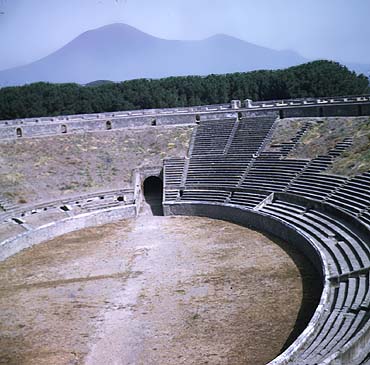Gladiatorial combats were introduced into Rome in 264 BCE; venationes (animal hunts) were introduced in 252 BCE. During the Republican period these took place in the Forum, where temporary platforms were constructed over the shops from which spectators could view the games. These platforms were called maeniana, after C. Maenius, the victor in the battle of Antium, who ordered them built. The earliest stone amphitheaters were built in Campania, to the south of Rome, rather than in the city itself; the photo above shows the remains of the amphitheater in Pompeii.
- Caius Curio, a rich friend of Julius Caesar, built the first amphitheater in the city of Rome in 59 BCE to hold games in memory of his father. It was a wooden structure, constructed of 2 semicircular theaters set back to back on pivots, that held 40,000 people. In the morning, plays were held in the theater. In the afternoon, with people still in their seats, the 2 theaters were turned face to face to form a circle in which games were held. It was given the Greek name amphitheatrum, even though it was an entirely Roman invention.
- The next amphitheater was built by Julius Caesar in the Campus Martius to hold special games for the dedication of his forum and the Temple of Venus. It was constructed of wood and intended to be temporary.
- L. Statilius Taurus, a friend of Augustus, who fought both in the war against Pompey and at Actium, built at his own expense the first stone amphitheater in Rome. It was dedicated in 29 BCE and probably stood in the southeastern part of the Campus Martius. It was burned in the fire of Nero in 64 CE.
- Caligula's stone amphitheater was never completed, but
Nero built a wooden amphitheater in the space of one year (57 CE). The amphitheatrum Neronis stood in the Campus Martius and was noted for its awnings of blue painted with stars.
Sources: John Pearson. Arena: The Story of the Colosseum, 1973; Samuel Ball Platner, Topography and Monuments of Ancient Rome, 1911; Lawrence Richardson. A New Topographical Dictionary of Ancient Rome, 1992.

